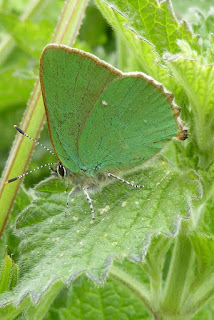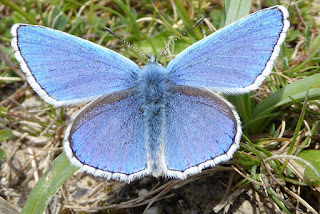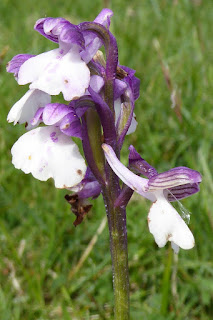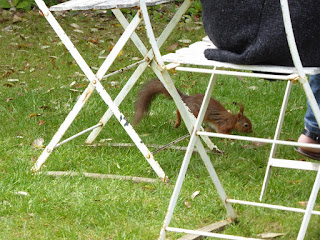With the Isle of Wight being the only place in the UK where Glanville fritillaries are found it was off to Southampton on Monday 17th May to catch the ferry to the Isle of Wight for a few days away. It was nice to see lots of early purple orchids flowering by the roadside along the A38 and the Devon bit of the A303, not so nice were the usual dead birds and animals by the roadside which this time included a fox and a roe deer.
We stopped at Mottisfont Estate near Romsey on the way to Southampton, a National Trust house and gardens we haven't visited before. It was very interesting and I managed to see a red kite flying high overhead on what was a warm and sunny day. Some large trout were seen in the river running through the gardens and I saw a nice beautiful demoiselle perched on the riverside vegetation and a holly blue flying through the woods.
The hour long ferry trip from Southampton to Cowes was very pleasent in the sunshine and we enjoyed a beer as I watched common terns and Sandwich terns fly past with the usual gulls.
The weather forecast for the week wasn't looking too good but the forecast seemed to change 12 hourly meaning we had to constantly adjust our plans, especially my butterfly plans which would need sunny and dry conditions, something that looked to be in short supply while we were going to be on the island.
Tuesday 17th was bright and sunny but cool and breezey and with cloud forecast for later in the day we headed off in the morning to The Needles and The Old and New Batteries. The Needles seemed smaller than I remember but The Batteries, managed by the National Trust, were very interesting, especially the New Battery where the British space programme was conducted under top security in the 1950's, something I knew nothing about.
The Needles, Isle of Wight
I managed to find a lone adult gannet flying past offshore along with a peregrine and kestrel along the clifftops and a raven busily devouring a dead rabbit. Whitethroats were heard singing and I saw my first butterfly of the trip, a very smart red admiral.
We then headed off along the south coast and stopped off at Whiteways Quarry, now a small car park off the main road and a top spot for butterflies. Unfortunately it was starting to cloud over earlier than forecasted and on arriving 3 butterfliers were already there with 1 of them having seen 3 Glanville Fritillaries earlier before the cloud rolled in - damn!
However I quickly found a wall and a grizzled skipper on a bare piece of chalky soil and scanning the vegetation along the back of the car park where it was sheltered from the wind I quickly found a small blue, a new butterfly for me - it was small but not really blue, being more a smokey grey, but it was very smart and beautiful nonetheless.
Small Blue
Small Blue
Small Blue
Scanning around further and I found at least 2 green hairstreaks, a small heath, a brown argus, at least another 2 small blues and a pair of common blue mating. I also saw a female Adonis blue - I wasn't sure at the time but since returning home and checking my photos I realise it was indeed one.
Common Blues mating
Female Common Blue
Grizzled Skipper
Brown Argus
Green Hairstreak
Small Heath
Female Adonis Blue
Female Adonis Blue
The two other butterfliers present had earlier seen Glanville fritillaries in a sheltered chine further along the coast road and so after getting my fill of some quality views of quality butterflies we headed off for a look. I found the chine but the wind was blowing right up it and the now total lack of sunshine meant that it was chilly too - a dark butterfly flew past but quickly disappeared from sight but was it a Glanville? After a fruitless search to refind it it was time to head off to Carisbrooke Castle and with a sense of frustration and impending dipping.
Beetle Sp. on Thrift - common along the cliffs
The next day was wet and windy and we headed off to the Roman villa at Brading but by lunchtime there were flashes of blue in the sky and the rain eventually stopped and so we headed off to Wheelers Bay at Ventnor, a good spot for Glanvilles and somewhere I expected to be sheltered from the wind. However it was very windswept and all I managed to find were 2 small whites battling over the flower clad cliffsides. Expecting another dip I caught sight of a dark butterfly flitting amongst the red valerian in a small and sheltered ravine and checking it out with binoculars it was indeed a Glanville fritillary - result! It kept disappearing amongst the vegetation and frustratingly stayed some distance away from the footpath but I did get a few record shots and at least I had seen one.
My first Glanville Fritillary
Heading back to the car and I kept my eyes open and amazingly while wandering through some boulders by the footpath in a slightly more sheltered area I disturbed a Glanville from the ground. It landed in some bushes and I got some nice shots of its beautiful underwings. Even more amazing was being able to pick it up and observe it very close too as it enjoyed the warmth of mammalian skin - it didn't want to move and so we carefully placed it on the underside of some leaves to protect it from ominous looking rain clouds that were fast approaching.
Glanville Fritillary - beautiful underside of wings
Glanville Fritillary - warming up in Davids hand
Glanville Fritillary
Glanville Fritillary
We had a quick walk on nearby Bonchurch Down, a good site for Adonis blues, but by now it was cold, cloudy and windy and it eventually began to rain and as a result it was totally butterflyless and so we headed off back to the hotel - but at least I had seen my target butterfly and the main purpose of my trip so at least I could now relax.
The next morning was warm and sunny but breezey and before heading off to Osborne House we drove to a sheltered quarry at Brook Down, another top butterfly site. The road to the quarry was closed due to resurfacing work so we walked uphill and across fields to the quarry where it was very warm in the sunshine and where butterflies were whizzing about - small blues, orange tip, grizzled skipper, dingy skipper and.....Adonis blues doing common blue impressions. Another result!
Brook Down Quarry
Dingy Skipper
Small Blue
Small Blue
AdonIs Blue - showing a peek of its brilliant blue upperwings
Grizzled Skipper
Dingy Skipper
The Adonis blues were a little worn and faded and I wasn't sure about their ID as despite being very blue I wasn't sure if they were blue enough and the black markings in the white borders giving a chequered effect didn't seem quite complete enough. I uploaded the 3 photos below to the excellent UK Butterflies website for ID help and quickly received a very detailed and scientific reply.
Adonis Blue
Adonis Blue - with damaged wings
Adonis Blue
Here is the reply I received :-
"These are all Adonis.
There are lots of reasons for this, some more subtle than others. The group of blues that Adonis belongs to (Lysandra) have prominent androconial furriness in the forewings that common blues lack. All these show this clearly [EDIT: the middle picture shows this clearly - the others indirectly], so cannot be common blues. The fringes are also a good sign. Common blue may show chequering in the inner half of the fringe, which is darker in tone than the outer, but all these show dark marks extending into the outer half of the fringe - and the inner half is not darker.
These are the obvious signs. There are other more subtle signs that come with experience of both butterflies".
Below are yet more photos of what were very beautiful butterflies and ones that I was very pleased to see.
Adonis Blue
Adonis Blue
Adonis Blue
Adonis Blue
A bonus was a field above the quarry full of green winged orchids, a new orchid for me and unexpected.
Green Winged Orchid
Green Winged Orchid
Green Winged Orchid - close up of green veins on petals
Green Winged Orchid - white form
On the drive to Osborne House we passed the chine where I had seen the flyby butterfly species a few days before and so a quick stop for a quick look did reveal a Glanville fritillary flitting about in the sunshine - some good views again and in a more natural setting than Davids hands!
Glanville Fritillary
Glanville Fritillary
Osborne House was very interesting and I added speckled wood, green veined white and brimstone to my butterfly list but even better was a red squirrel running around the cafe tables at the Swiss cottage - I had hoped to see one but wasn't really expecting to.
Red Squirrel
Red Squirrel
Durbar Room, Osborne House
The next day and it was an early morning ferry trip from Yarmouth back to the mainland at Lymington. More common terns and Sandwich terns were seen on the crossing but a surprise were eider ducks around the estuary mouth - 5 males, an immature male and 2 females.
And so my butterfly trip was a great success despite the iffy weather and with a few nice birds, a new orchid, my first English red squirrel, history and culture, beautiful scenery and good food to boot as well - a really good time away



























































